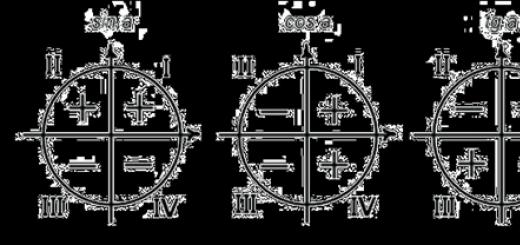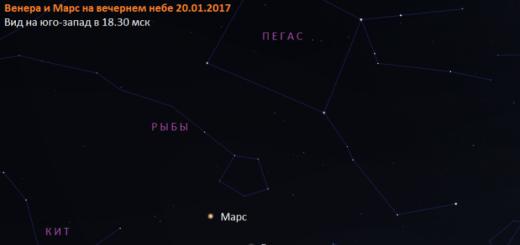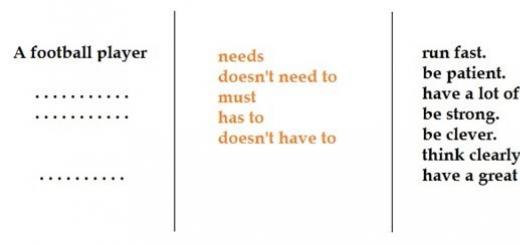If you compare circles of different sizes, you will notice the following: the sizes of different circles are proportional. This means that when the diameter of a circle increases by a certain number of times, the length of this circle also increases by the same number of times. Mathematically this can be written like this:
| C 1 | C 2 | ||
| = | |||
| d 1 | d 2 | (1) |
where C1 and C2 are the lengths of two different circles, and d1 and d2 are their diameters.
This relationship works in the presence of a coefficient of proportionality - the constant π, already familiar to us. From relation (1) we can conclude: the length of a circle C is equal to the product of the diameter of this circle and a proportionality coefficient π independent of the circle:
C = π d.
This formula can also be written in another form, expressing the diameter d through the radius R of a given circle:
С = 2π R.
This formula is precisely the guide to the world of circles for seventh graders.
Since ancient times, people have tried to establish the value of this constant. For example, the inhabitants of Mesopotamia calculated the area of a circle using the formula:
Where does π = 3 come from?
In ancient Egypt, the value for π was more precise. In 2000-1700 BC, a scribe called Ahmes compiled a papyrus in which we find recipes for solving various practical problems. So, for example, to find the area of a circle, he uses the formula:
| 8 | 2 | |||||
| S | = | ( | d | ) | ||
| 9 |
From what reasons did he arrive at this formula? – Unknown. Probably based on his observations, however, as other ancient philosophers did.
In the footsteps of Archimedes
Which of the two numbers is greater than 22/7 or 3.14?
- They are equal.
- Why?
- Each of them is equal to π.
A. A. Vlasov. From the Examination Card.
Some people believe that the fraction 22/7 and the number π are identically equal. But this is a misconception. In addition to the above incorrect answer in the exam (see epigraph), you can also add one very entertaining puzzle to this group. The task reads: “arrange one match so that the equality becomes true.”

The solution would be this: you need to form a “roof” for the two vertical matches on the left, using one of the vertical matches in the denominator on the right. You will get a visual image of the letter π.
Many people know that the approximation π = 22/7 was determined by the ancient Greek mathematician Archimedes. In honor of this, this approximation is often called the “Archimedean” number. Archimedes managed not only to establish an approximate value for π, but also to find the accuracy of this approximation, namely, to find a narrow numerical interval to which the value π belongs. In one of his works, Archimedes proves a chain of inequalities, which in a modern way would look like this:
| 10 | 6336 | 14688 | 1 | |||||||||
| 3 | < | < | π | < | < | 3 | ||||||
| 71 | 1 | 1 | 7 | |||||||||
| 2017 | 4673 | |||||||||||
| 4 | 2 | |||||||||||
can be written more simply: 3,140 909< π < 3,1 428 265...
As we can see from the inequalities, Archimedes found a fairly accurate value with an accuracy of up to 0.002. The most surprising thing is that he found the first two decimal places: 3.14... This is the value we most often use in simple calculations.
Practical Application
Two people are traveling on a train:
- Look, the rails are straight, the wheels are round.
Where is the knock coming from?
- Where from? The wheels are round, but the area
circle pi er square, that’s the square that knocks!
As a rule, they become acquainted with this amazing number in the 6th-7th grade, but study it more thoroughly by the end of the 8th grade. In this part of the article we will present the basic and most important formulas that will be useful to you in solving geometric problems, but to begin with we will agree to take π as 3.14 for ease of calculation.
Perhaps the most famous formula among schoolchildren that uses π is the formula for the length and area of a circle. The first, the formula for the area of a circle, is written as follows:
| π D 2 | |
| S=π R 2 = | |
| 4 |
where S is the area of the circle, R is its radius, D is the diameter of the circle.
The circumference of a circle, or, as it is sometimes called, the perimeter of a circle, is calculated by the formula:
C = 2 π R = π d,
where C is the circumference, R is the radius, d is the diameter of the circle.
It is clear that the diameter d is equal to two radii R.
From the formula for circumference, you can easily find the radius of the circle:
where D is the diameter, C is the circumference, R is the radius of the circle.
This basic formulas, which every student should know. Also, sometimes it is necessary to calculate the area not of the entire circle, but only of its part - the sector. Therefore, we present it to you - a formula for calculating the area of a sector of a circle. It looks like this:
| α | |||
| S | = | π R 2 | |
| 360 ˚ |
where S is the area of the sector, R is the radius of the circle, α is the central angle in degrees.
So mysterious 3.14
Indeed, it is mysterious. Because in honor of these magical numbers they organize holidays, make films, hold public events, write poetry and much more.
For example, in 1998, a film by American director Darren Aronofsky called “Pi” was released. The film received many awards.
Every year on March 14 at 1:59:26 a.m., people interested in mathematics celebrate "Pi Day." For the holiday, people prepare a round cake, sit at a round table and discuss the number Pi, solve problems and puzzles related to Pi.
Poets also paid attention to this amazing number; an unknown person wrote:
You just have to try and remember everything as it is - three, fourteen, fifteen, ninety-two and six.
Let's have some fun!
We offer you interesting puzzles with the number Pi. Unravel the words that are encrypted below.
1. π r
2. π L
3. π k
Answers: 1. Feast; 2. File; 3. Squeak.
Math enthusiasts around the world eat a piece of pie every year on the fourteenth of March - after all, it is the day of Pi, the most famous irrational number. This date is directly related to the number whose first digits are 3.14. Pi is the ratio of the circumference of a circle to its diameter. Since it is irrational, it is impossible to write it as a fraction. This is an infinitely long number. It was discovered thousands of years ago and has been constantly studied since then, but does Pi still have any secrets? From ancient origin until the uncertain future, here are some of the most interesting facts about Pi.
Memorizing Pi
The record for memorizing decimal numbers belongs to Rajvir Meena from India, who managed to remember 70,000 digits - he set the record on March 21, 2015. Previously, the record holder was Chao Lu from China, who managed to remember 67,890 digits - this record was set in 2005. The unofficial record holder is Akira Haraguchi, who recorded himself on video repeating 100,000 digits in 2005 and recently published a video where he manages to remember 117,000 digits. The record would become official only if this video was recorded in the presence of a representative of the Guinness Book of Records, and without confirmation it remains only an impressive fact, but is not considered an achievement. Math enthusiasts love to memorize the number Pi. Many people use various mnemonic techniques, for example poetry, where the number of letters in each word matches the digits of Pi. Each language has its own versions of similar phrases that help you remember both the first few numbers and the whole hundred.

There is a Pi language
Mathematicians, passionate about literature, invented a dialect in which the number of letters in all words corresponds to the digits of Pi in exact order. Writer Mike Keith even wrote a book, Not a Wake, which is entirely written in Pi. Enthusiasts of such creativity write their works in full accordance with the number of letters and the meaning of numbers. This has no practical application, but is a fairly common and well-known phenomenon in the circles of enthusiastic scientists.

Exponential growth
Pi is an infinite number, so by definition people will never be able to establish the exact digits of this number. However, the number of decimal places has increased greatly since Pi was first used. The Babylonians also used it, but a fraction of three whole and one eighth was enough for them. Chinese and creators Old Testament and were completely limited to three. By 1665, Sir Isaac Newton had calculated the 16 digits of Pi. By 1719, the French mathematician Tom Fante de Lagny had calculated 127 digits. The advent of computers has radically improved human knowledge of Pi. From 1949 to 1967 the number known to man digits skyrocketed from 2037 to 500,000. Not long ago, Peter Trueb, a scientist from Switzerland, was able to calculate 2.24 trillion digits of Pi! It took 105 days. Of course, this is not the limit. It is likely that with the development of technology it will be possible to install even more exact figure- since Pi is infinite, there is simply no limit to accuracy, and only the technical features of computer technology can limit it.

Calculating Pi by hand
If you want to find the number yourself, you can use the old-fashioned technique - you will need a ruler, a jar and some string, or you can use a protractor and a pencil. The downside to using a can is that it needs to be round and accuracy will be determined by how well a person can wrap the rope around it. You can draw a circle with a protractor, but this also requires skill and precision, as an uneven circle can seriously distort your measurements. A more accurate method involves using geometry. Divide a circle into many segments, like a pizza into slices, and then calculate the length of a straight line that would turn each segment into isosceles triangle. The sum of the sides will give the approximate number Pi. The more segments you use, the more accurate the number will be. Of course, in your calculations you will not be able to come close to the results of a computer, however, these simple experiments allow you to understand in more detail what the number Pi is and how it is used in mathematics. 
Discovery of Pi
The ancient Babylonians knew about the existence of the number Pi already four thousand years ago. Babylonian tablets calculate Pi as 3.125, and an Egyptian mathematical papyrus shows the number 3.1605. In the Bible, Pi is given in the obsolete length of cubits, and the Greek mathematician Archimedes used the Pythagorean theorem, a geometric relationship between the length of the sides of a triangle and the area of the figures inside and outside the circles, to describe Pi. Thus, we can say with confidence that Pi is one of the most ancient mathematical concepts, although the exact name of this number appeared relatively recently.

New look at Pi
Even before the number Pi began to be correlated with circles, mathematicians already had many ways to even name this number. For example, in ancient mathematics textbooks one can find a phrase in Latin that can be roughly translated as “the quantity that shows the length when the diameter is multiplied by it.” Ir rational number became famous when the Swiss scientist Leonhard Euler used it in his work on trigonometry in 1737. However, the Greek symbol for Pi was still not used - this only happened in a book by a lesser-known mathematician, William Jones. He used it already in 1706, but it went unnoticed for a long time. Over time, scientists adopted this name, and now it is the most famous version of the name, although it was previously also called the Ludolf number.

Is Pi a normal number?
The number Pi is definitely strange, but how much does it obey the normal ones? mathematical laws? Scientists have already resolved many questions related to this irrational number, but some mysteries remain. For example, it is not known how often all the numbers are used - the numbers 0 to 9 should be used in equal proportion. However, statistics can be traced from the first trillions of digits, but due to the fact that the number is infinite, it is impossible to prove anything for sure. There are other problems that still elude scientists. It is quite possible that further development science will help shed light on them, but at the moment it remains beyond human intellect.

Pi sounds divine
Scientists cannot answer some questions about the number Pi, however, every year they understand its essence better and better. Already in the eighteenth century, the irrationality of this number was proven. In addition, the number has been proven to be transcendental. This means that there is no specific formula that allows you to calculate Pi using rational numbers. 
Dissatisfaction with the number Pi
Many mathematicians are simply in love with Pi, but there are also those who believe that these numbers are not particularly significant. In addition, they claim that Tau, which is twice the size of Pi, is more convenient to use as an irrational number. Tau shows the relationship between circumference and radius, which some believe represents a more logical method of calculation. However, to unambiguously determine something in this issue is impossible, and one and the other number will always have supporters, both methods have a right to life, so this is just an interesting fact, and not a reason to think that you should not use the number Pi.
The number 3.14 is fundamental to nature, it is almost magical. Composer David MacDonald translated it into forte piano notes and reproduced its sound, accurate to 122 decimal places.
The most popular and frequently used constant in the world - this is the number PI. Pi is a mathematical constant. It is infinite and means the ratio of the circumference of a circle to the length of its diameter. Approximately pi is equal to 3.14. Pi is not only mathematical concept. It is considered mystical and mysterious.
Here I wanted to remind you of a few more fun facts about this number.
March 14th is Pi Day. American physicist Larry Shaw in 1987 calculated that on March 14 at 01:59 the date and time are equal to the first digits of Pi, namely 3.14159. Interestingly, he was born on the same day genius physicist Einstein and astronomer Schiaparelli.
The number Pi appeared in 1706, and was invented by the scientist William Jones.
The number Pi is known to come from the geometry of a circle. It’s funny that the number 360 (degrees of a circle) can be seen in the 359th position, after the decimal point in Pi.
In both the Greek and Latin alphabet, Pi is the sixth letter.
49 decimal places in Pi are enough to calculate the circumference of the universe to within the size of one hydrogen atom.
In the biblical book of kings (7:23) this number is given in the description of the altar of Solomon's Temple
Scientists never tire of determining the number of decimal places. So in 2008 their number was 5 trillion, and in 2011 there were already 10 trillion characters.
Fans of the unique number Pi compete with each other to see who can remember all the numbers after the decimal point more accurately and without errors. At the moment, the record belongs to the Chinese guy Liu Chao. In 2006, he spent 24 hours reproducing almost 68 thousand decimal places.
In 18888, Dr. Edwin Goodwin of Indiana attempted to file a patent for the calculation of Pi, claiming to have received this knowledge from certain celestial powers. Fortunately, the number Pi never became patented thanks to another American professor who found an inaccuracy in his calculations.
Some biologists argue that the human brain is programmed to search for natural combinations that produce the ratio Pi, and in fact it is one of the cornerstones of human evolution.
In Seattle they decided to erect a monument dedicated to the number Pi. It now stands on the steps of the Museum of Art.
Mystical meaning Pi is revealed by adding up the first 144 decimal places. The result is the “number of the beast” equal to 666.
In Great Britain in 2008, mysterious circles suddenly appeared in crop fields. Scientists saw a pattern in them. Surprisingly, the first ten digits of Pi were encrypted in the circles.

Pi is also called the Ludolf number in honor of Ludolf van Zeilen. This is a scientist who devoted his life to calculating and researching the first 36 digits of a number. The tombstone on the scientist's grave with these engraved numbers mysteriously disappeared.
For intelligent and attractive men, the Givenchy fashion house has released a cologne under the laconic name “Pi”
In 1998, director Darren Anofsky made the film Pi: Faith in Chaos about how calculating all the signs of Pi can lead to madness.

Usually our knowledge about the number Pi ends here: 3.14159. Not everyone even remembers that this number shows the ratio of the circumference of a circle and its diameter.
Pi is an irrational number, meaning it cannot be written as a simple fraction.
Moreover, it is infinite and non-periodic decimal, which makes it one of the most mysterious numbers known to man.
First calculation
Archimedes was the first to talk about the existence of the number PiIt is believed that Archimedes was the first to talk about the number Pi. Around 220 BC. he derived the formula S = Pi R2 by approximating the area of a circle based on the area of the polygon inscribed in the circle and the area of the polygon around which the circle was circumscribed. Both polygons outlined the lower and upper boundaries of the circle, thereby allowing Archimedes to realize that the missing piece (Pi) was somewhere between 3 1/7 and 3 10/71.
The famous Chinese mathematician and astronomer Zu Chongzhi (429–501) calculated Pi a little later, dividing 355 by 113, but it is still unknown how he came to this conclusion, since no records of his work have survived.
The area of the circle is actually unknown
Pi is an irrational numberIn the 18th century, Johann Heinrich Lambert proved the irrationality of Pi. Irrational numbers cannot be expressed as whole fractions. Any rational number can always be written as a fraction, where the numerator and denominator are expressed as a whole number. You can, of course, imagine Pi as a simple ratio of the circumference and diameter (Pi = C/D), and it will always turn out that if the diameter is represented by an integer, then the circumference will be expressed by an integer, and vice versa.
The irrationality of the number Pi is expressed in the fact that we never know the real circumference (and subsequently the zone) of the circle. This fact seemed inevitable to scientists, but some mathematicians insisted that it would be more accurate to imagine that a circle had an infinite number of tiny angles, rather than to assume that the circle itself was straight.
Using Buffon's problem you can calculate Pi without using a circleScientists first paid attention to Buffon's needle problem in 1777. This problem has been recognized as one of the most intriguing in the history of geometric probability. Here's how it works.
If you were faced with the task of throwing a needle of a certain length onto a piece of paper on which lines of the same length were drawn, then the probability that the needle would cross one of the lines would be equal to the number Pi.
There are two variables in throwing a needle: 1. the angle of incidence and 2. the distance from the center of the needle to the nearest line. The angle can vary from 0 to 180 degrees and is measured from a line parallel to the lines on the paper.
It turns out that the probability of the needle landing this way is 2/Pi, or about 64%. Accordingly, the number Pi can theoretically be calculated using this technique, if there is someone who has the patience to carry out this dreary experiment. Please note that there is no circle involved here.
It may be difficult to imagine all this, but if you have the desire, you can try.
Pi and the tape problem
The circumference of a circle increases strictly in relation to PiImagine taking a ribbon and wrapping it around the globe. (To simplify the experiment, we suggest taking it as a truth that the Earth is a flat sphere with a circumference of 40,000 km). Now try to determine the required length of tape that can be wrapped around the Earth at a distance of 2.54 cm above its surface. If you think that the second tape should be longer, then you are not alone in your guesses. But in fact, this is not at all true: the second tape will be only 2Pi longer, which is approximately 16 cm.
And here is the solution: let’s say that the Earth is a perfect sphere, a huge circle, the length of which is 40,000 km (along the equator). Therefore, its radius will be equal to 40000/2Pi, or 6.37 km. Now the second ribbon, which passes at a distance of 2.54 cm above the surface of the Earth: its radius will increase by only 2.54 cm relative to the radius of the Earth. We get the equation C = 2 Pi(r+1), which is equivalent to C = 2 Pi(r) + 2 Pi. Based on this, we can say that the circumference of the second ribbon will increase by only 2 Pi. In fact, it doesn’t matter what initial radius you take into account (the Earth and the hoops of a basketball basket), increasing this radius by 2.54 cm, the circumference will increase by only 2Pi (about 16 cm).
Navigation
Pi is used in calculations in navigation.Pi plays a very important role in navigation, especially when it comes to determining location over a large area. The size of a person is very small relative to the Earth, so it seems to us that we are always moving in a straight line, but this is not so. For example, airplanes fly in a circle and their path must be calculated in order to calculate the flight time, the amount of fuel and take into account all the nuances.
Additionally, when you determine your location on Earth using GPS, Pi plays an important role in these calculations.
But what about navigation, which requires even more precise positioning than flying from New York to Tokyo? Susan Gomez NASA employee, says that most NASA calculations are made using the numbers 15 or 16, especially when it comes to very precise calculations for a program that controls and stabilizes spaceships during the flight.
Signal Processing and Fourier Transform
Pi plays an important role in signal transmissionMost often, the number Pi is used in such geometric problems, as a measurement of a circle, however, its role is also important in signal processing, mainly in the process known as the Fourier transform, which transforms the signal into a spectrum of frequencies. The Fourier transform is called the "frequency domain map" of the original signal, where it relates to both the frequency domain and the mathematical operations that combine the frequency domain and a function of time.
People and technology use this phenomenon when basic signal conversion is needed, such as when your iPhone receives a message from a cell phone tower, or when your ear distinguishes between sounds of different frequencies. Pi, which appears in the Fourier transform formula, plays a decisive and, at the same time, strange role in the transformation process, since it lies in the exponent of the Euler number (the well-known mathematical constant 2.71828...)
Therefore, you can thank Pi every time you make a cell phone call or listen to a broadcast signal.
Normal probability distribution
Using Pi, you can calculate the vibration force of a large structureAnd if the use of Pi is expected in such operations as the Fourier transform, which relates directly to signals (and, accordingly, waves), then its appearance in the normal probability distribution formula is surprising. You've no doubt encountered this notorious distribution before—it's involved in a wide range of phenomena we observe on a regular basis, from dice rolls to test scores.
Every time you discover that Pi is hidden in an equation, imagine that there is a circle hidden somewhere among the mathematical formulas. In the case of a normal probability distribution, Pi is expressed in terms of the Gaussian integral (also known as the Euler-Poisson integral), which is square root from Pi. In fact, all that is required is small changes in the variables in the Gaussian integral to calculate the normalization constant of the normal distribution.
One common but counterintuitive application of the Gaussian integral involves “white noise,” a normally distributed random variable used to predict everything from the effect of wind on an airplane to the vibration force of a beam in a large-scale structure.
Rivers make their winding path in accordance with the number PiA completely unexpected fact is that the number Pi is related to meandering rivers. The floodplain of a river most often looks like a sinusoid, which bends in one place and then in another, crossing the plain. In mathematical terms, it can be described as the length of a winding path divided by the length of the river from source to mouth. It turns out that regardless of the length of the river and the number of its bends, its sinuosity is approximately equal to the number Pi.
Albert Einstein made several suggestions as to why rivers behave this way. He noticed that water flowed faster on the outside of the bend, causing more damage. coastline and bending enhancement. Then these bends “meet” each other and sections of the river are connected. This back and forth motion seems to constantly correct itself as the river continues to bend in accordance with Pi.
Pi and the Fibonacci sequence
Pi can be calculated using the Febonacci sequenceUsually, 2 methods have always been used to calculate Pi: the first was invented by Archimedes, the second was developed by the Scottish mathematician James Gregory.
Each subsequent number in the Fibonacci sequence is equal to the sum of the previous two numbers. The sequence looks like this: 0, 1, 1, 2, 3, 5, 8, 13, 21, 34, 55, 89, ... It is endless.
And since the arctangent of 1 is equal to Pi/4, this means that Pi can be expressed through the Fibonacci sequence through the following equation: arctan(1)*4=pi.
Besides the fact that the Febonacci sequence is just a beautiful selection of numbers, it plays an important role in some natural phenomena. It can be used to model and describe large number phenomena in mathematics, science, art and nature. Mathematical ideas that the Febonacci sequence leads to, such as golden ratio, spirals, curves, are highly valued for their aesthetic appearance, but mathematicians are still trying to explain the depth of the connection.
Pi and quantum mechanics
Pi is also closely related to Einstein's theory of relativity.Pi is, without a doubt, the inevitable and complex basis of our world, but what about our endless universe? Pi works throughout the universe and is directly involved in explaining the nature of the cosmos. It is a fact that many formulas used in the field quantum mechanics, which governs the world of atoms and nuclei, contain Pi.
Some of the most famous equations in this field are the equations gravitational field Einstein's equations (also known as simply Einstein's equations). These are 10 equations compiled within the framework of the theory of relativity that describe fundamental interaction gravity as a result of the curvature of space-time by mass and energy. The amount of gravity present in a system is proportional to the amount of energy and momentum, with the constant of proportionality associated with G being a numerical constant.
We hope that our article has helped you better understand the nature and purpose of the number Pi. Who would have thought that it is an integral part of our everyday life and even natural processes occur in accordance with its meaning.










